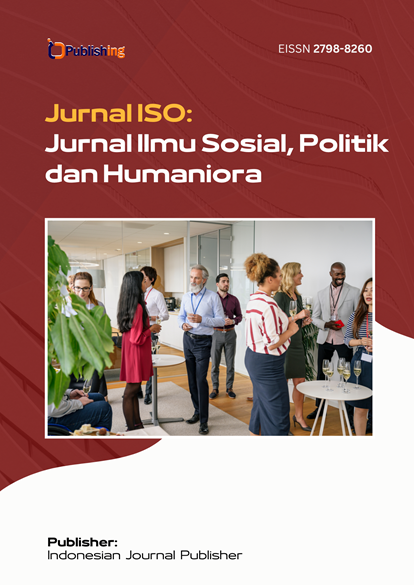The Status and Role of Women In The Society of Nomads In Central Asia
DOI:
https://doi.org/10.53697/iso.v4i2.1906Keywords:
Development, Human Rights, Humanity, Nationality, Society, Spirituality, Ideology, Immunity, Security, Education, EnlightenmentAbstract
The aim of this research is to study the role and status of women in nomadic society, as well as to identify the specifics of the perception of the image of women in traditional philosophical worldview. The attention given to the study of the role of women and their image in philosophy remains of constant interest, as this issue has both ideological and practical significance. In the context of the continuous transformation of modern society’s structure under the influence of various factors, the image of women, their functions, and roles in society are undergoing changes. Primarily, the reasons for the changing image of women include the pragmatization of human relationships, shifts in value orientations, and the increasing complexity of gender and national self-identification processes. The authors identified the significant role of women in nomadic civilization, particularly in the formation and organization of the family and in the upbringing of children. The research also revealed that women of the steppe could participate in crucial decisions concerning their clan and people, as evidenced by the involvement of nomadic women in military battles.The practical significance of this research is determined by the fact that its results can be used in further studies on the role of women in organizing the life of nomads, as well as in research on gender equality. All of the above reflects the relevance of this research and calls for a more comprehensive study of the gender role of women, both in ancient nomadic civilization and in modern society.
References
Болотов С. С Сырдарьи. В: Русский вестник. №3, 1866. - с. 184.
Плано Карпини Дж. д. История Монголов. Путешествие в восточные страны Плано Карпини и Рубрука. -Москва, 1957. - с. 37.
Гильом де Рубрук. Путешествие в Восточные страны. Путешествие в Восточные страны Плано Карпини и Рубрука. - Москва, 1957. - с. 100-101; Маковецкий П.Е. Материалы для изучения юридических обычаев киргизов. Вып. 1: Материальное право. Семипалатинский областной статистический комитет. - Омск, 1886. - с. 32.
Мэн-да бэй-лу (“Полное описание монголо-татар”). Памятники письменности Востока. ХХУІ. - Москва, 1975. -с. 80.
Плано Карпини Дж. д. История Монголов. Путешествие в восточные страны Плано Карпини и Рубрука. - Москва, 1957. - с. 36.
Рашид ад-Дин кн.2, 1952. - с.261
Книга Марко Поло: переводы. - Москва, 1997. - с. 236.
Андреев И.Г. Описание средней орды киргиз-кайсаков. - Алматы, 1998, - с. 65, 66.
Gokalp Z., Türklerde Milli İktisat Devreleri. В: Gökalp, Z., Makaleler VIII. Ankara: Gündüz Matbaası, 1981. - s. 90–91.
Бернштам А.Н. Социально-экономический строй орхоно-енисейских тюрок в VI-VIII вв. – Л., 1946. - с.94-98.
Толыбеков С.Е. Кочевое общество казахов в XVII - начале XX века: Полит.-экон. анализ. - [Перераб. и расшир. изд.]. - Алма-Ата: Наука, 1971. - с 536.
Ғарифолла Есім. Адам-зат. Алматы, 2002. -312 б.
Андреев И.Г. 1998, с.62-63; Левшин А.И. 1996. с.335,338; Гродеков Н.И. 1889. - с.47.
Гродеков Н.И., Гродеков Н. И. Киргизы и каракиргизы Сыр-Дарьинской области // Н. И. Гродеков. - Прижизн. изд.Т. 1: Юридический быт. - 1889. Ташкент: типо-литография С. И. Лахтина, 1889 - 205 с.
Грач А.Д.Древние кочевники в центре Азии. - Москва: ГРВЛ. 1980. -256 с.
Кубарев Г. В. Культура древних тюрок Алтая (по материалам погребальных памятников). Новосибирск: Изд-во ИАЭТ СО РАН, 2005. -400 с.
Гильом де Рубрук. Путешествие в Восточные страны. Путешествие в Восточные страны Плано Карпини и Рубрука. - Москва, 1957, - с. 101.
Кляшторный, С. Г. Историко-культурное значение Суджинской надписи. Проблемы востоковедения 5: 1959. - с.162–169.
Прошлое Казахстана в источниках и материалах // Под ред. проф. Асфендиярова С.Д. и проф. Кунте П.А. // Сб. 1: (V в. до н.э. - XVII в. н.э.) – Алматы: 1997. - 383 с.
Гумилев Л. Древние тюрки. - Алма-Ата, 1999. – С.125.
Secret History, § 64, de Rachewiltz, Commentary, 332; Isenbike Togan, “The Qongrat in History,” in History and Historiography of Post-Mongol Central Asia and the Middle East: Studies in Honor of John E. Woods, ed. Judith Pfeiffer, Sholeh A. Quinn, and Ernest Tucker (Wiesbaden: Harrassowitz, 2006), 70–2; see also the Altan Tobci, 12–13.
Энн Ф. Бродбридж, Women in Steppe Society Published online by Cambridge University Press: 10 July 2018.
Women and the Making of the Mongol Empire. Publisher: Cambridge University Press, Print publication year: 2018. - pp.101-134. DOI: https://doi.org/10.1017/9781108347990.005
A., Patrick Scott Smith, M. “Scythian Women”. World History Encyclopedia. Last modified June 30, 2021. https://www.worldhistory.org/article/1783/scythian-women/
Anne F. Broadbridge, Women in Steppe Society, Published online by Cambridge University Press: 10 July 2018.
Li, Alchemist, trans. Waley, 71. Also Noriyuki Shiraishi, “Avraga Site: The “Great Ordū” of Genghis Khan”, in Beyond the Legacy of Genghis Khan, ed. Linda Komaroff (Leiden: Brill, 2006), 83-93 and esp. 84.
Sultanalieva, Syinat. (2023). “Nomadity of Being” in Central Asia. Narratives of Kyrgyzstani Women’s Rights Activists Politics and History in Central Asia, Singapore // https://link.springer.com/book/10.1007/978-981-19-5446-7
Потапов Л.П. Народная этногония как один из источников для изучения этнической и социальной истории (на материале тюркоязычных кочевников) // Советская этнография. – 1975. - № 6. (соавтор С.М. Абрамзон), -с.123.
Downloads
Published
How to Cite
Issue
Section
License
Copyright (c) 2024 Yesimova Anarkul Elmuratovna

This work is licensed under a Creative Commons Attribution 4.0 International License.













